Figure 1.
There is evidence that epilepsy and disorders of learning and behavior can all arise from abnormal excitability and disrupted synaptic plasticity in the developing brain. This abnormal plasticity can result from genetic conditions. In addition, epilepsy development (epileptogenesis) and/or seizures during early post-natal development may alter synaptic plasticity and contribute to learning and behavioral disorders. Abnormalities in synaptic plasticity can arise from alterations in receptors, signaling molecules or neurotrophins. Multiple of these molecules are known to be altered by early life seizures and genetic conditions associated with IDD, ASD and epilepsy.

